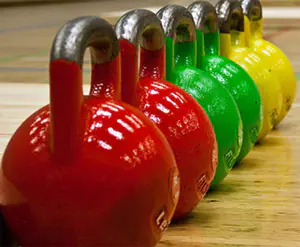Flexibility - this is the athlete’s ability to fully use the potential anatomical mobility of several joints when performing various exercises included in the working kettlebell complex.
The flexibility of the human body depends on the individual structural characteristics of joints, joint capsules, and the properties of the muscular-ligamentous apparatus. The length of the muscles is of great importance. As a rule, athletes with prominent muscles (fitness jocks, bodybuilders, bodybuilders) do not tolerate the load associated with strength endurance.
Thus, flexibility depends not only on the anatomical ability of muscles and tendons to stretch, but also on contractile abilities antagonist muscles. In this regard, strength and flexibility can be developed using the same exercises included in your typical kettlebell complex, since contraction of some muscles causes relaxation of others.
In kettlebell lifting there is no need to develop the maximum possible flexibility for a person. Mobility is necessary only in the elbow, shoulder and hip joints - mainly for the correct mastery of the pushing technique.
To develop joint mobility, the following exercises are recommended:- Exercises on the bar: hangs, hanging swings, lowering into the hanging from behind, inversion lifting.
- Exercises on a gymnastic wall: bending over with legs secured to a bar, hanging, hanging leg raises.
- Exercises with a weight on a gymnastic wall: lying down, holding the weight in your arms raised forward above your head - lowering the weight behind your head; lying down, legs secured, weight behind the head - raising and lowering the body; standing, weights in outstretched arms - bend forward below the level of the bench.
- Snatch of only one weight from both hands (with an emphasis on stretching the muscles of the shoulder joint).
- Squats with a kettlebell behind your head (elbows pointing forward and up).
- In the rack - lifting a weight with both hands and lowering it behind your head.
- Rotation of the weight with one and two hands.
- Differentiated Exercises for the entire spectrum of abdominal muscles (such as slowly raising and lowering your legs while lying down).
Exercises for developing flexibility, like other special exercises, are usually used at the end of each training session. At the same time, performing muscle stretching exercises requires a favorable temperature regime (to avoid injuries). Since mobility in the joints develops rather slowly, exercises to develop flexibility should be performed in a series of several approaches.
Is the kettlebell collapsible? Or sports weights made of cast iron?
In the training phase aimed at developing flexibility, Do not use maximum and sub-maximum loads. For these purposes, lighter weights from the full range of the weightlifter’s arsenal are used: cast iron sports weights (16, 24, 32 kg). Perfectly useful for home use collapsible kettlebell, which we discussed in detail in a previous publication, successfully combines the entire possible and impossible range of the load you need. Similarly, just as collapsible dumbbells are superior in convenience and versatility to their cast, cast-iron counterparts, the same is true with this sports equipment...
So, we’ve sorted out the weight – to develop flexibility, we take it specifically less, but the question is: what exercises to do?
- Well, of course, first of all, we include in the training both the main and warm-up movements of kettlebell lifting, but we do them with the greatest possible amplitude, thoroughly stretching all the muscles involved. “Pull and pull” and concentrate well on the tension phase.
- We also use a variety of movements (all kinds of pulls and hangs at different angles on bars and parallel bars), as well as entire stretching complexes, both static and dynamic, including work with a sparring partner.
- Well, the third pillar on which stretching and flexibility in kettlebell lifting rests is a newfangled trend in modern “iron sports”, the so-called kettlebell fitness. What it is? In fact, this is a complex of all kinds of different gymnastic movements performed with weights as a load. Here, lightweight, “purely symbolic” cast, cast iron, sports weights, or collapsible analogues with a minimum of attached additional weight are usually used.
That’s probably all that was planned to tell you about the development of flexibility in kettlebell lifting. In the next article we will focus on self-control issues, and learn the most important rule of athletes involved in weight lifting: “Do no harm!” After all, any successes and victories fade, and training becomes no joy if your health is already undermined. “How to avoid harming yourself?” - read in our next article...
Post Views: 95


